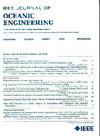A Robust Graph-Based Bathymetric Simultaneous Localization and Mapping Approach for AUVs
IF 3.8
2区 工程技术
Q1 ENGINEERING, CIVIL
引用次数: 0
Abstract
Due to the position drift of inertial navigation systems, it is still challenging to achieve long-term and accurate position estimates during underwater navigation. The seabed topography has been proven to be effective in aiding information for accurate positioning benefiting from its rich spatial variation. With the advantage of the multibeam echosounder (MBES) in efficient bathymetric survey, the simultaneous localization and mapping (SLAM) approach can be performed using bathymetric data in unknown environments for underwater vehicles to get good position estimates. The SLAM performance relies on the number and accuracy of loop closures heavily. Thereby, the capabilities of the data association method and solver in dealing with the uncertainties of vehicle pose estimates, bathymetric data, and topographic features affect the SLAM performance strongly. This work proposes a new graph-based bathymetric SLAM method to improve the robustness of the uncertainties in both factor-graph construction and optimization stages. In the front end, on the base of a matching suitability-based MBES submap construction method, a dual-stage bathymetric point cloud registration approach that is able to detect most false loop closures is proposed. In the back end, a robust optimizer based on Frechet distance is introduced to further identify and remove the false loop closures missed in front end. Experiments using field MBES bathymetric data sets are conducted to verify the effectiveness of the proposed approach.基于鲁棒图的自动潜航器测深同步定位和绘图方法
由于惯性导航系统的位置漂移,在水下导航过程中实现长期和准确的位置估计仍然具有挑战性。海底地形因其丰富的空间变化而被证明是精确定位的有效辅助信息。利用多波束回声测深仪(MBES)在高效水深测量方面的优势,可以在未知环境中使用水深测量数据对水下航行器进行同步定位和绘图(SLAM),以获得良好的位置估计。SLAM 的性能主要取决于闭环的数量和精度。因此,数据关联方法和求解器在处理车辆姿态估计、水深数据和地形特征的不确定性方面的能力对 SLAM 性能影响很大。本研究提出了一种新的基于图的测深 SLAM 方法,以提高因子图构建和优化阶段对不确定性的鲁棒性。在前端,在基于匹配适宜性的 MBES 子图构建方法的基础上,提出了一种双阶段测深点云注册方法,该方法能够检测到大多数错误的环路闭合。在后端,引入了基于 Frechet 距离的稳健优化器,以进一步识别和消除前端漏掉的错误环路闭合。利用实地 MBES 测深数据集进行了实验,以验证所提方法的有效性。
本文章由计算机程序翻译,如有差异,请以英文原文为准。
求助全文
约1分钟内获得全文
求助全文
来源期刊

IEEE Journal of Oceanic Engineering
工程技术-工程:大洋
CiteScore
9.60
自引率
12.20%
发文量
86
审稿时长
12 months
期刊介绍:
The IEEE Journal of Oceanic Engineering (ISSN 0364-9059) is the online-only quarterly publication of the IEEE Oceanic Engineering Society (IEEE OES). The scope of the Journal is the field of interest of the IEEE OES, which encompasses all aspects of science, engineering, and technology that address research, development, and operations pertaining to all bodies of water. This includes the creation of new capabilities and technologies from concept design through prototypes, testing, and operational systems to sense, explore, understand, develop, use, and responsibly manage natural resources.
 求助内容:
求助内容: 应助结果提醒方式:
应助结果提醒方式:


